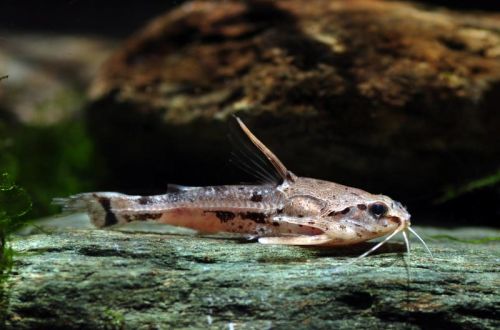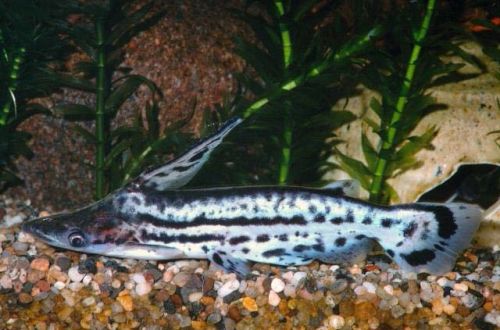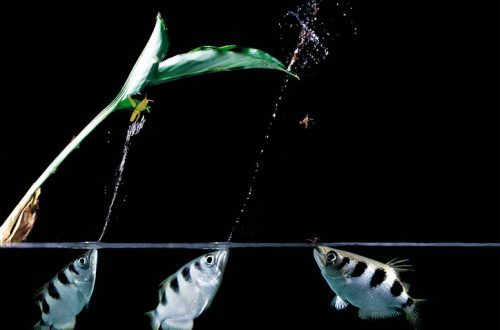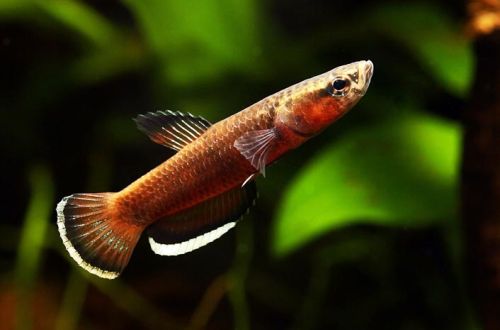
marble catfish
The marbled talking catfish, scientific name Amblydoras nauticus, belongs to the family Doradidae (Armored). Easy to keep unpretentious fish. It gets along well with many other species, including aggressive ones, if they are not too large. The only drawback is that it is nocturnal, so during the daytime it prefers to hide.

Contents
Habitat
It comes from South America, endemic to the Peruvian part of the Amazon basin. Inhabits streams and slow-flowing rivers, floodplain lakes and swamps. In the daytime, the fish finds shelter among the roots and underwater vegetation, and at night, gathering in groups, they swim out in search of food.
Brief information:
- The volume of the aquarium – from 50 liters.
- Temperature – 23-28°C
- Value pH — 5.5–7.5
- Water hardness – 2–21 dGH
- Substrate type – sandy
- Lighting – subdued
- Brackish water – no
- Water movement – little or no
- The size of the fish is about 7 cm.
- Food – any sinking food
- Temperament – peaceful
- Content in a group of 3-4 individuals
Description
Adults reach a length of about 7 cm. Catfish have a massive head with bone plates. The pectoral and dorsal fins are equipped with sharp spikes, and a strip of sharp spines stretches along the lateral line. The coloration is light gray or silver with dark spots all over the body, reminiscent of a marble ornament. Sexual dimorphism is weakly expressed, males and females do not have pronounced external differences.
The structure of the bone plates on the head allows the catfish to make sounds, for this ability they received the prefix to their name “speaking”.
Food
An omnivorous species, will accept most popular sinking foods (flakes, pellets). A useful addition to the diet will be bloodworms, daphnia, brine shrimp, live or frozen. Feeding should be done shortly before the lights are turned off.
Maintenance and care, arrangement of the aquarium
The optimal size of the aquarium for a group of 3-4 fish starts from 50 liters. The design should provide for numerous shelters in the form of thickets of plants and snags, or any other decorative items. Any soft substrate.
Due to the hidden lifestyle, it is almost impossible to see the Marble talking catfish during the day. In order to still observe it during the period of night activity, you can install special lighting of the red spectral composition, which is turned on after the main light is turned off. The fish does not see the red wavelength and, believing that it is night, swims out of its hiding place.
The ability to adapt to a wide range of hydrochemical values greatly facilitates the maintenance of this species of catfish. Regular cleaning of the aquarium from organic waste, weekly replacement of part of the water with fresh water, as well as uninterrupted operation of the equipment will be the key to stable water conditions and balance of the internal ecosystem.
Behavior and Compatibility
A peaceful calm fish that will be a great addition to the South American biotope. Perfectly compatible with other species of cichlids, tetras, corydoras and others. Thanks to its protection, it is able to get along with unprepared aggressive or quarrelsome fish.
Breeding / breeding
Not bred in aquariums. According to some reports, in nature, catfish during the mating season build foam-air nests among plants, where they lay eggs. The male later guards the clutch. Whether parental care extends to emerging fry is unknown.
Fish diseases
Being in favorable conditions is rarely accompanied by a deterioration in the health of fish. The occurrence of a particular disease will indicate problems in the content: dirty water, poor quality food, injuries, etc. As a rule, eliminating the cause leads to recovery, however, sometimes you will have to take medication. Read more about symptoms and treatments in the Aquarium Fish Diseases section.





